Heading out the door? Read this article on the new Outside+ app available now on iOS devices for members! Download the app.
There are a lot of reasons to go ultralight—and thru-hiking is only one of them. Want to cover more ground on a regular backpacking trip? Carrying an ultralight load can speed up your pace. New to hiking and want to give yourself a few more miles before fatigue sets in? Ditto. Injured? You could also stand to benefit. Many of the bags below are three to four pounds lighter than their traditionally-constructed counterparts—which means that much less weight on your knees.
No matter your motivations, you’ve come to the category at a good time: these days, more and more brands are getting into the ultralight game. That means uber-light gear, once the sole domain of small cottage brands, is easier to find, more reliable, and more affordable than ever before. This year, we tested 20 bags from 15 top gear makers. The 10 below emerged as the best of the best. Here are our favorite ultralight backpacking packs of 2025.
At a Glance
- Best for Thru-Hikers: Zpacks Arc Haul Ultra 60 ($399)
- Best Value: Durston Kakwa 55 ($199-260)
- Most Comfortable: Seek Outside Flight 3 ($359)
- Best for New Ultralighters: REI Co-op Flash 50 Air ($299)
- Lightest: Nashville Pack The Cutaway 40 ($350)
- Best Women’s: Wild Brush Glow 45 ($400)
- Best for Long Trails: Outdoor Vitals CS40 Ultra ($330)
- Best for Fastpackers: Gossamer Gear Fast Kumo 36 ($190)
- Most Weatherproof: ULA Ultra CDT ($280)
- Best for Big Loads: SWD Wolverine ($399)
- How to Choose
- How We Test
- Meet Our Testers
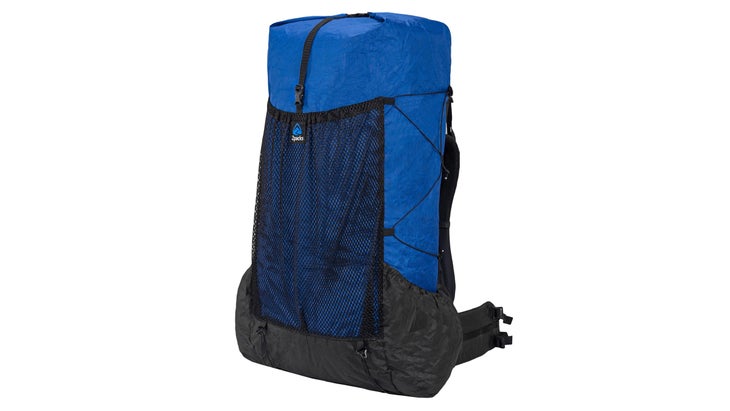
Best for Thru-Hikers
Zpacks Arc Haul Ultra 60
$399 at Zpacks (Women’s) $399 at Zpacks (Men’s)
Weight: 1 lb 5 oz
Tester-Recommended Carry Capacity: 35 lbs
Sizes: Unisex, S-L torso and S-XL hipbelt
Pros and Cons
⊕ Extremely water resistant
⊕ Shoulder strap adjustability
⊕ Internal frame boosts comfort
⊗ Hipbelt and chest pockets not included
⊗ Pricey
The Zpacks Arc Haul Ultra seems to transcend physics: this svelte little bag weighs a mere 1.3 pounds yet can support up to 40 pounds thanks to a combination of ultralight fabrics and a robust suspension. In fact, it’s the lightest framed pack on our list. As a result, it’s become our go-to for everything this season—from gear-intensive weekends to long trail section hikes to backcountry skiing in the Andes.
The hipbelt ($33) and shoulder strap pockets ($43) are removable—and, unfortunately, sold separately—which let testers strip it down for technical mountaineering or beef up the organization for more traditional hikes. Additional pockets, bottle sleeves, and other accessories —also sold seperately—are easy to add, and both the backpanel and frame are removable if you need to roll the pack into a suitcase for travel. Our biggest organizational gripe was that the side bottle pockets were tough to reach on the move.
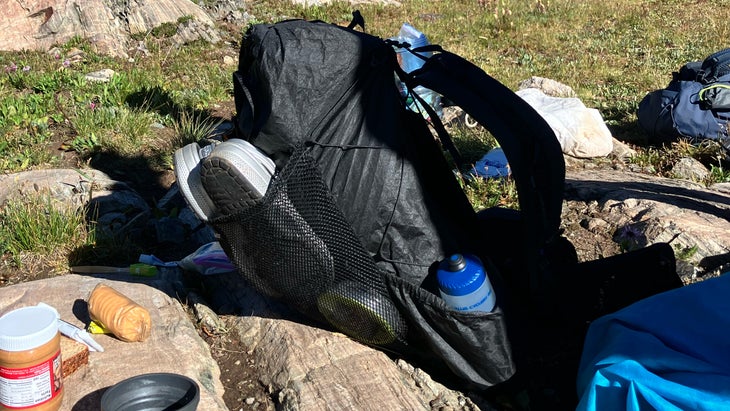
The minimalist layout—basically a single huge compartment with an eight-liter shove-it sleeve made from stretchy mesh—made it easy to fit a wide range of gear, from bulky layers to climbing equipment to a full-size bear canister. Adventure traveler and guide Kelly McNeil loaded the Arc Haul Ultra up for mountaineering trips to Chile and Argentina this summer, and found the pack’s carbon-fiber ladder frame rigid enough to provide weight transfer to the hips for loads up to 40 pounds—pretty impressive for an ultralight pack. Even better, it breathed well under those loads thanks to the arch-shaped frame, which suspends the pack off the back similar to a traditional trampoline backpanel. The result was at least an inch of space between our backs and the pack—and blessedly plentiful air flow.
Also rare for the category: the shoulder strap adjustment system. We were able to move the shoulder strap’s attachment point up or down, which helped us dial-in the perfect fit and avoid awkward gapping above the shoulders, which can lead to rubbing along the collarbone over extended hikes. Testers reported zero shoulder or armpit chafing over the course of the season.
Finally, the Arc Haul Ultra also impressed in the durability department. Our sample easily survived all its international travels with aplomb. It got tossed on ice in Patagonia, dragged through off-trail brambles in Colorado, and stormed on in Vermont. Taped seams kept water out, and we’ve yet to spot a scratch on the Ultra 100x fabric (an ultra-high-molecular-weight polyethylene, similar to Dyneema), or on the dorsal pocket mesh. “I put that pack through the wringer and it still looks like new,” says McNeil. Biggest bummer: price.
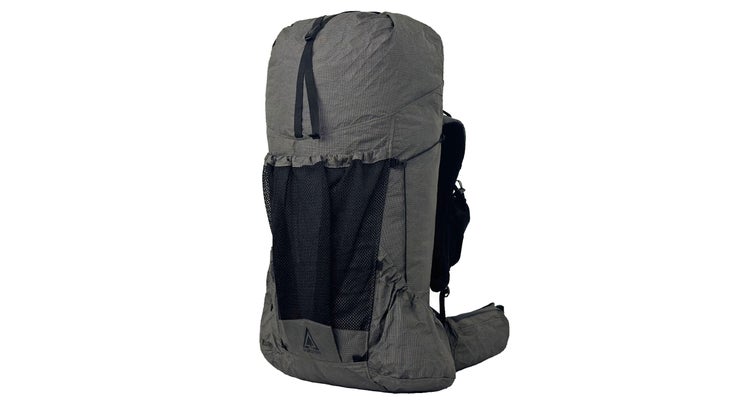
Best Value
Durston Kakwa 55
Weight: 1 lb 14 oz
Tester-Recommended Carry Capacity: 35 lbs
Sizes: Unisex, S-L
Pros and Cons
⊕ Durable
⊕ Well-organized
⊕ Affordable
⊕ Good carry capacity
⊗ Not seam-taped
⊗ Not very breathable
The Kakwa isn’t the cheapest pack on this list. But at nearly half the price of both the ZPacks Arc Haul Ultra and the Seek Outside Flight 3, it’s by far the most affordable in its size class. You get a lot for the price, too: durability, organization, and outstanding carrying comfort. The durabilty—among the best in the test—comes from Kakwa’s Ultra 200x fabric—a high-tenacity version of Challenge Sailcloth’s brand-name UHMWPE.
“I abused this pack fabric while squeezing through boulders and bushwhacking through scrubby Vermont wetland and haven’t seen a single pinhole,” reported Outside senior gear editor Benjamin Tepler. The internals were equally robust. An inverted-U-shaped, seven-millimeter aluminum frame connects directly to the bottom of the sewn-in hipbelt, letting us carry up to 38 pounds of gear comfortably. The rigid connection provides efficient transfer of weight, directing most of the loading forces to our hips, not our shoulders. Thick, mesh-wrapped hip fins cushioned the weight, and load-lifters let us pull heavy cargo in toward the spine.
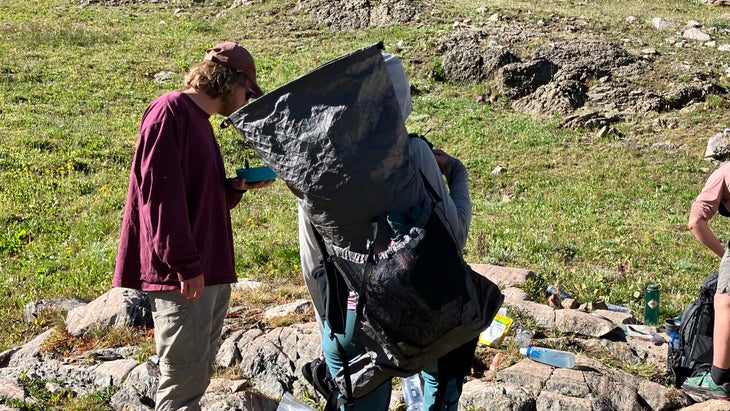
“I never felt unstable or off balance,” said Janelle Bohey, a PhD candidate in ecology who did her summer fieldwork near Crested Butte, Colorado. “The pack sat well and moved with my body, even on scrambly sections, steep ascents, and loose terrain.” Note: While the frame is removable, we don’t recommend testing that; it’s near-impossible to re-insert, and if you do it incorrectly, it’s prone to busting through the boot of the pack, as one tester discovered in Patagonia this fall.
Dual zippered hipbelt pockets are each big enough to fit an iPhone, and twin vest-style chest pockets were perfect for bear spray, or a couple of granola bars. Testers also appreciated the thru-hiker-oriented layout of the main bag. A dorsal shove-it sleeve swallowed rain layers, and the asymmetrical side pockets serve dual needs: one slants forward for easy water bottle access, while the other is deep and straight for tents, poles, or sun umbrellas. The deeper side pocket also sports a full-length vertical zip for easy access.
One comfort ding: without mesh, the unadorned sheet of Ultra that serves as the backpanel lies flat against the pack, leaving testers sweaty.
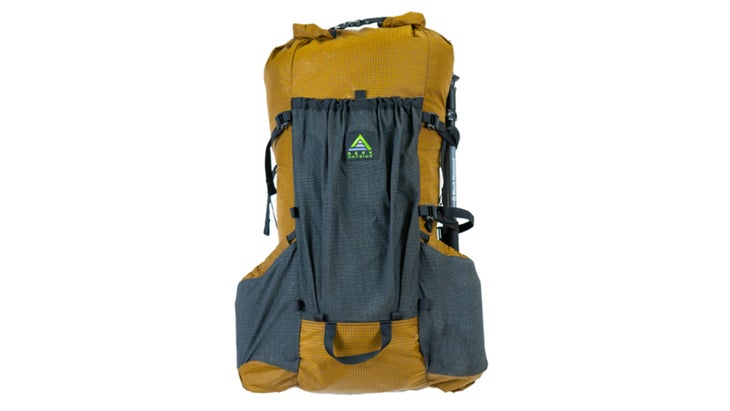
Most Comfortable
Seek Outside Flight 3
Weight: 2 lbs 11 oz
Tester-Recommended Carry Capacity: 40 lbs
Sizes: Unisex, 22” – 25” torso and S-XL hipbelt
Pros and Cons
⊕ Thick cushioning
⊕ Outstanding carry capacity
⊕ Durable
⊗ Overly simplistic organization
⊗ On the heavier side
With burly fabrics and outstanding load capacity, the Flight 3 is one of the most heavy-duty packs we tested this season (and at almost 3 pounds, was one of the heaviest). We expected that level of toughness from Seek Outside, a gear-maker with hunting roots. What we didn’t expect was that it would be so dang comfy, too.
The pack’s perimeter frame is made of 7075 T6 aluminum (that’s aircraft grade) with a horizontal cross-stay for extra stability. Combined with a broad, body-wrapping hipbelt and beefy foam pads behind the shoulder blades, mid-back, and lumbar, we never experienced soreness of any kind, even with 40-pound loads onboard. (We did, however, experience back sweat; while this one has a few shoulder and lumbar pads to lift the pack off the back, it wasn’t enough to allow for significant air flow.)
“The hip belt and sternum strap hugged me in a way no other pack has,” said one tester after a backpacking trip in the Colorado Front Range. “It’s a firm, harness-like grip that makes the weight you’re carrying feel really controlled.”
The pack comes in two versions: 210-denier Ultragrid (a burly ripstop nylon) and 200-denier Ultra fabric. Our version, the 200-denier Ultra, easily handled thorny bushwhacking and light scrambling, and the Ultra stretch mesh on the cinchable dorsal and side pockets never snagged.
Organization was straightforward to a fault. “There’s no toplid, inner pocket, or any zippered pocket on the whole thing,” complained Colorado-based tester Scott Reed. “The three large bucket pockets with shock cord closures on the outside of the pack are the only real opportunities for quick access.” Still, if you’re looking for a durable, no-nonsense pack with superior carrying comfort, this one’s got your name on it.
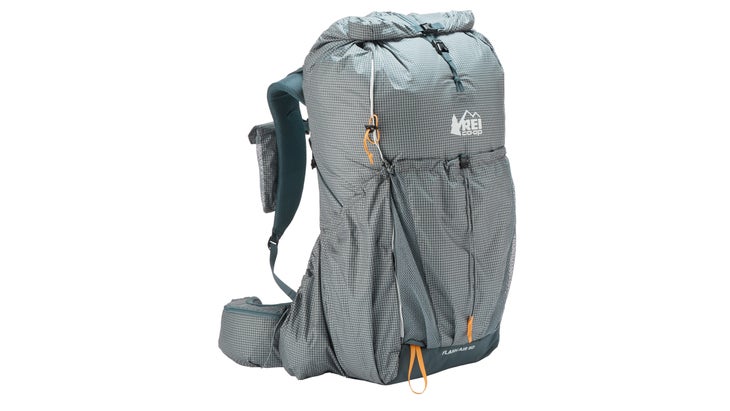
Best for New Ultralighters
REI Co-op Flash Air 50
$299 at REI (Women’s) $299 at REI (Men’s)
Weight: 1 lb 14 oz (M)
Tester-Recommended Carry Capacity: 25 lbs
Sizes: M’s S-L and W’s XS-M
Pros and Cons
⊕ Comfortable
⊕ Relatively breathable
⊗ Small pockets
⊗ Modest carry capacity
At just under two pounds, the comfy, body-hugging Flash Air 50 straddles the line between lightweight and ultralight, making it our top choice for folks who want to dabble in the UL universe without truly committing to a Spartan frameless pack. Over a long season of testing on trails from Minnesota to Texas, the Flash Air stood out for its ease of carry.
“This is the best pack I’ve ever had in terms of carrying comfort,” reported tester and guide Bloom Davis, who carried 35 pounds (including a critical two pounds of Twizzlers) on a 38-mile trek of the Wonderland Trail this summer. The pack handled the weight and didn’t sway (though Davis noted it was most comfortable with about 25 pounds onboard).
The Flash Air’s secret? It has both a real suspension—an hourglass-shaped spring-steel frame, wrap-around hipbelt, the works—and a moderately breathable backpanel. Broad hip fins fully enveloped the iliac crests, and air channels cut in the mesh-wrapped backpanel foam provided some air flow behind the lumbar and torso, keeping us from swamping out on steep climbs in Colorado. The pack’s 210-denier nylon (reinforced with an UHMWPE ripstop grid) was fine for on-trail use, but we wouldn’t take it bushwhacking; it sustained a couple of pinprick holes by the end of the summer.
Our only real complaint about the Flash Air 50 was the sizing of its pockets. The twin water bottle pockets and external shove-it sleeve lacked stretch and were tough to access when the pack was full. The shoulder strap pocket barely fit a smartphone, and the hipbelt pockets maxed out at a couple of bars. We’d still recommend this pack for weekend trips with a slimmed-down kit—just maybe not for a gear-intensive thru-hike.
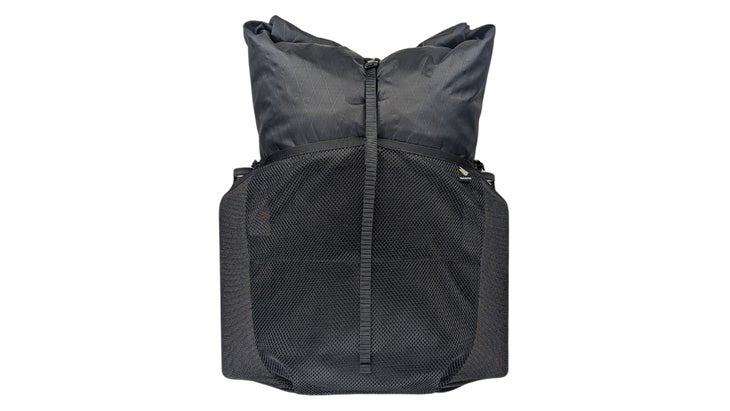
Lightest
Nashville Pack The Cutaway 40
Weight: 1 lb
Tester-Recommended Carry Capacity: 25 lbs
Sizes: Unisex, 16”-20” torso, 16”-20.5” shoulder straps, and 28”-48” hipbelt
Pros and Cons
⊕ Extremely light
⊕ Modular, vest-style shoulder straps
⊕ Tons of accessible pockets
⊗ Poor breathability
Not only was this the lightest pack in the test (a single pound?! Pinch us.) but it was also the most thoughtfully organized. “It just felt smart as heck,” said Zettie Shapey, a former thru-hiker who used this frameless pack on weekend trips all around New England last summer.
The dual side bottle pockets, a stash pocket on the base of the pack, and six (yes, six) chest-strap pockets were all easy to reach. “I was able to grab sunscreen, beanie, sunglasses, snacks, a Garmin, map, water, layers, rainlayers, and headphones all without stopping to take off my pack,” Shapey said. A large mesh shove-it pocket held bulkier items like a fleece, and a shelf pocket within that meant we could keep smaller items up top without losing them forever in the cavernous depths.
We also loved the broad vest straps, which distributed weight evenly across the chest and shoulders. Better yet, the shoulder straps attach to the top of the backpanel via six total strips of webbing. That means you can adjust the length, width, or angle of the straps on the fly. Three modular sternum straps also made it easy for curvier testers to accommodate bigger breasts.
The Cutaway typically comes in recycled 210-denier nylon with an UHMWPE grid and inner PU coating, but you can custom-order it in a variety of different materials. Our version was Graflyte, a new, waterproof fabric that boasts eight times the strength-to-weight ratio of steel but feels soft rather than stiff and crinkly like Dyneema. Our testers busted through wet branches and brambles throughout the Northeast, but the pack showed zero signs of wear at the end of the summer.
Our only beef? While the Graflyte kept water out, it also kept our sweat in: the unadorned, fabric backpanel stuck to our backs with even the slightest swelter.

Best Women’s
Wild Brush Glow 45
Weight: 1 lb 8 oz
Tester-Recommended Carry Capacity: 20 lbs
Sizes: Women’s custom sizing
Pros and Cons
⊕ Good organization
⊕ Fun colors
⊕ Curved straps accommodate bigger busts
⊕ Woman-owned
⊗ Load-lifters sold separately
⊗ Limited carry capacity
Most ultralight pack brands give you three color choices: black, white, or gray (yawn). But at Wild Brush—a woman-owned brand specializing in women’s packs—the bags are anything but boring. Every pack features a bold, colorful, artist-designed print. And each one is entirely custom-made according to your torso length, waist circumference, and bust size—making it a fast favorite among our female testers.
“The S-shaped shoulder straps and sliding sternum strap meant the girls never felt squashed or strapped down,” said one Colorado-based tester. “And the fabric lining the padded straps was soft and smooth, which meant I was able to hike in just a sports bra on an 80-degree day without chafing.” In those temperatures, however, the backpanel—just a flat sheet of fabric—left us drenched with sweat, par for the course for frameless packs of this ilk.
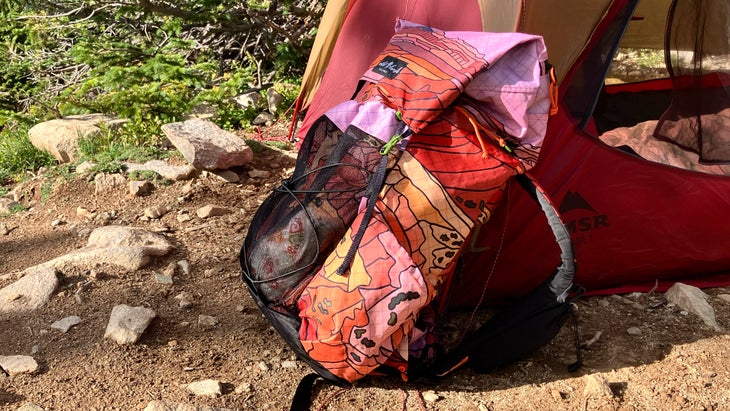
Organization is simple: two hipbelt pockets (each fit a smartphone), two chest pockets, and three external pockets including a shove-it sleeve and lateral bottle pouches. While large, the side pouches weren’t reachable on the move. Fortunately, each chest pocket fit a 500-milliliter soft flask—enough to stay hydrated without stopping. The rolltop easily expanded to fit a weekend’s worth of camping and climbing gear, and paracord compression straps let us cinch the bag down to daypack size for summit scrambles. The pack’s EXP200 (body) and EXP400 (bottom) fabric never tore, even while butt-scooting across the aptly named Knife’s Edge on Capitol Peak in Colorado, and the water-shedding laminate was plenty sufficient to deflect light rain.
Our biggest complaint: While Wild Brush offers all kinds of customization features, including a Kula cloth snap, top strap, hydration port, and load-lifters, the latter feels like they should come standard. Our sample came without, and loads topping 25 pounds left some testers with sore shoulders.

Best for Long Trails
Outdoor Vitals CS40 Ultra
Lab-tested weight: 1 lb 11 oz (M)
Lab-tested total volume: 48 liters (M)
Tester-Recommended Carry Capacity: 35 lbs
Sizes: Unisex, S-L torso and S-L hipbelt
Pros and Cons
⊕ Lightweight
⊕ Comfortable carry
⊕ Carbon frame
⊗ Average organization
⊗ Minimal padding
Thru-hikers, add this one to your vision board. With its smart combination of light weight, durability, and comfort, the CS40 Ultra is built to go the distance. Like a few of the packs on this list, the CS40 comes equipped with load-lifters, a real hipbelt, and a full frame. The dual carbon stays add just an ounce each but boost the CS40’s load-carrying capacity to 35 pounds.
Even more impressive: testers found the CS40 remained comfortable even fully-loaded thanks to the hipbelt’s dual adjustment points and broad hip wings. While the belt’s minimalist padding left our more bony-hipped testers sore, others found it perfectly contoured to prevent hot spots, even after sweaty, 20-mile days in the Appalachians.
A U-shaped foam back panel provides targeted padding. While the close-to-body fit did inhibit breathability, it also prevented pack sway. “I could cinch down the main compartment and not feel any wobble during summit trips,” said Colorado tester Robin Mino after a season of bagging Fourteeners.
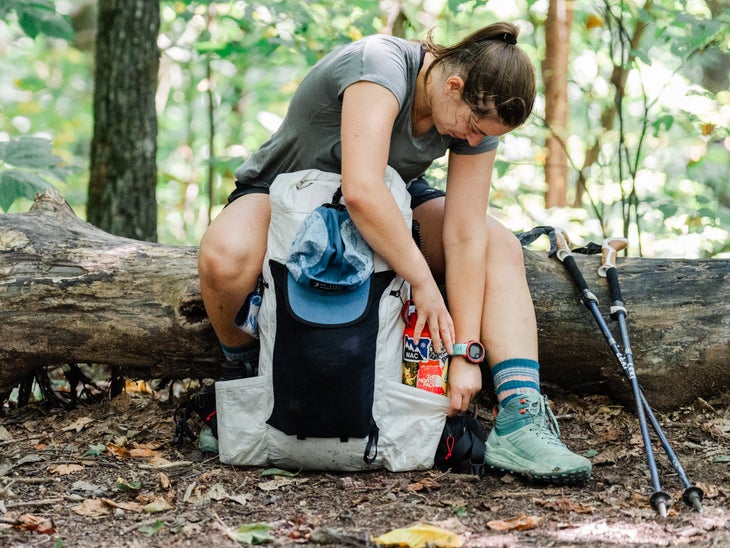
Organization was decent. The main bag is sufficiently cavernous to fit a bear canister while maintaining room for the rest of your kit, and fully extending the rolltop adds about 5 liters above the pack’s stated volume. Two small zippered hip pockets fit snacks and sunscreen, and each side pocket (angled for accessibility while hiking) fits a Nalgene. The dorsal stretch pocket was perfect for stuffing wet layers.
While the pack isn’t seam-taped and won’t keep your gear safe during extended downpours, the waterproof Ultra 200 fabric and roll-top design kept gear dry through both light rain and wet bushwhacks. Both the abrasion-resistant Ultra 200 and accessory stretch mesh ended the season without a scratch.

Best for Fastpackers
Gossamer Gear Fast Kumo
$190 at Garage Grown Gear $190 at Gossamer Gear
Weight: 1 lb 5 oz (S/M)
Tester-Recommended Carry Capacity: 20 lbs
Sizes: Unisex, S/M and M/L
Pros and Cons
⊕ Extremely light
⊕ Well organized
⊗ Fiddly buckles
⊗ Small pockets
⊗ Limited carry capacity
You shouldn’t have to pay more to carry less volume. And—fastpackers rejoice—a brand finally agrees. The Kumo 36 was far and away the most affordable ultralight pack specifically for fastpackers that we tested—and one of the most comfortable.
The weight savings come from stripping unnecessary features (like long zippers and excessive pockets) and using high-end materials. The pack body and boot are made from polyurethane-coated 70- and 100-denier Robic nylon, respectively, and the fastenings are all downsized to shave even more weight. We loved the Robic nylon, which emerged tear-proof at the end of the season, but found the small buckles fiddly.
In lieu of a frame, the Kumo relies on a 10-millimeter-thick removable foam backpanel, which supports up to 25 pounds (and also doubles as a sit pad). The EVA foam is insulative, however, and while it has a few holes in it to reduce weight, the lack of proper air channels makes it pretty sweaty against the back.
The Kumo’s features are tailored to fastpackers’ needs, from the dual-zippered hipbelt pockets, which we could operate one-handed to grab subscreen and granola bars, to the wide, vest-style shoulder straps, which spread loads evenly across the upper body. Thru-hiking testers also appreciated the removable hipbelt, trash stash pocket, and D-rings for lashing foam sleeping pads to the top of the pack.
The four chest pockets kept snacks, lip balm, a PLB, sunscreen, and smartphone handy, which made it easy to stay moving and log long miles, reported Emily Watson-Cook, a field biologist who used the Kumo for an 118-mile section of the Pacific Northwest Trail this summer. “I also appreciated how compact and maneuverable the pack was during dense bushwhacks in Eastern Washington,” she added, noting the svelte, back-hugging silhouette.
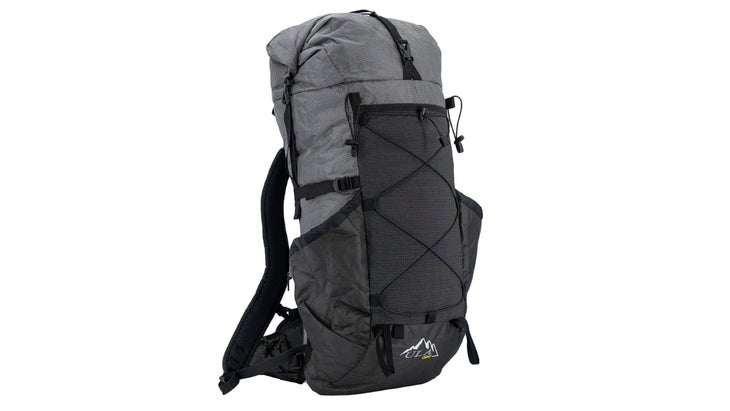
Most Weatherproof
ULA Ultra CDT
Weight: 1 lb 12 oz (M torso, M hipbelt)
Tester-Recommended Carry Capacity: 25 pounds
Sizes: Unisex, S-XL torso and XS-XXL hipbelt
Pros and Cons
⊕ Lightweight
⊕ Durable
⊕ Nearly waterproof
⊗ Limited carry capacity for the weight
Think ultralight packs are flimsy? The Ultra CDT puts that myth to bed. Though the pack weighs in under two pounds, its 200- and 400-denier Ultra fabric neatly survived a season of scrapes with willows, pine branches, and granite ridgelines. “I would hear those ominous abrasion sounds when I was squeezing through gaps in the rock, but no holes,” reported gear tester and thru-hiker Robin Mino after a season of hiking in Rocky Mountain National Park.
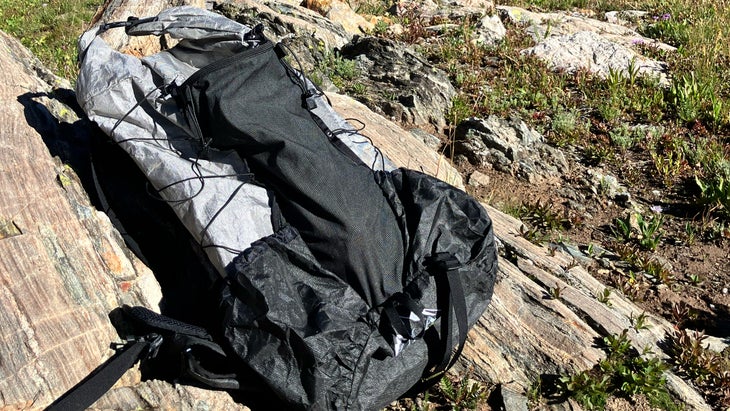
The pack also suffered no leaks: thanks to a waterproof laminate on the Ultra fabric, Mino’s gear stayed dry even during full-on downpours. When the sun came out, she was able to utilize the pack’s dorsal stretch pocket to stash her wet tent fly without worrying about it soaking the rest of the gear.
Other organizational features were equally thoughtful. The removable hipbelt sports generous twin pockets: one fits a day’s worth of snacks, while the other fits bug spray, lip balm, and sunscreen (and, with a little wriggling, an iPhone 12). As for load-carrying capacity, the Ultra CDT performed about average for a frameless pack; Mino was able to pack 25 pounds (including a small bear canister) for long weekends. At that weight, though, she found herself wishing for load-lifters, available from ULA for an additional $50 by custom request.
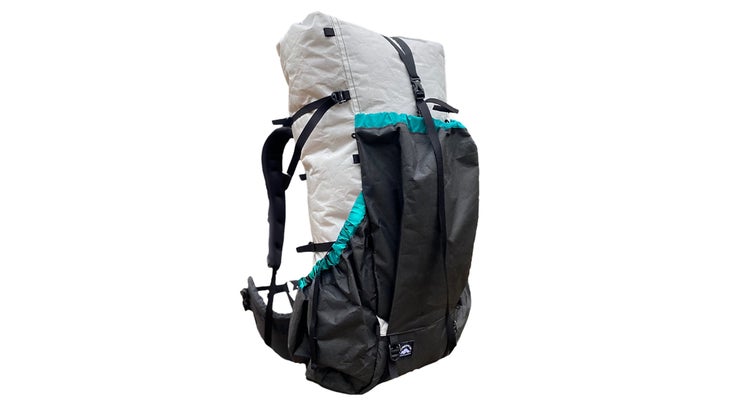
Best for Big Loads
SWD Wolverine 50
Weight: 2 lbs 3 oz
Tester-Recommended Carry Capacity: 50 lbs
Sizes: Unisex, S-L torso and 26-34” hipbelt
Pros and Cons
⊕ High-mobility floating hip belt
⊕ Crazy-high load capacity
⊕ Water-resistant
⊕ Customizable pack and pocket colors
⊕ Durable
⊗ Limited organizational features
Like Marvel’s namesake brooding antihero, the Wolverine is ridiculously strong, virtually damage proof—and a little rough around the edges. Its biggest superpower is its load-carrying capacity: The SWD Wolverine was built to haul heavy loads without contributing to the problem. It clocks in at just over two pounds yet can carry up to 60—an impressive ratio we put to the test on heavily-loaded training hikes on Colorado’s Front Range. While we were happiest with loads around 30 to 50 pounds, that’s still a feat considering this bag’s lightweight pedigree.
The secret is a generously padded, free-floating hip belt that moves with the wearer’s body. Thick compression straps lash loads tight against the spine, and two robust 7075 aluminum stays and a rigid backpanel transfer all that weight to the hipbelt. After using it to traverse sketchy boulder gardens around Nevada alpine lakes and carry packrafts through technical canyon hikes near the border of Idaho, the Wolverine proved itself reliable and sway-free, even on scrambly terrain.
And while The Wolverine may not have bones made of adamantium, it’s still basically indestructible. The main pack bag and dorsal shove-it pouch are both made of abrasion-resistant and waterproof Ultra 400x—one of the burliest fabrics in the test. After months of dragging the pack around gneiss boulders and volcanic canyons, we noted no obvious wear. While it’s not seam-sealed (one packrafting tester experienced leakage on rougher paddling trips) the laminated fabric provided excellent protection against mild to moderate rainfall.
The Wolverine did have one clear weakness: organization. Yes, testers appreciated the cavernous dorsal pouch and forward-sloping side pockets, which made it easy to reach a water bottle without stopping. But on-the-go organization needed refinement. There are no hipbelt pockets, chest pockets, or toplid—so while we could keep some snacks in the bottle pockets and strapped gear to the exterior via the pack’s multiple lashing points, most testers would have preferred more pocket options.

How to Buy an Ultralight Pack
Ultralight packs look simple, but there are plenty of nuances hiding under the surface. Here are a few things to keep in mind before you buy.
Framed vs. Frameless
There are two main categories within ultralight backpacking packs: framed packs and frameless packs. Framed packs come with full suspensions—usually metal rods, perimeter frames, or rigid plastic frame sheets that help redirect loading forces to the hipbelt. By ensuring that most of the weight sits on your hips and not your shoulders, framed packs let you get away with carrying more weight—sometimes up to 50 or 60 pounds—comfortably.
If you’re carrying a kit that’s truly dialed for ultralight hiking (usually 20 pounds or less, including your food and water), a frame might be overkill. In that case, you might want to go with a frameless pack—essentially a big empty bag without any rigid internal structure. Frameless packs are usually several ounces to a pound lighter than their framed counterparts, making them the true pinnacle of ultralight packs (albeit not usually the most comfortable options).
Volume
Ultralight packs are intended for hikers with extremely pared-down kits. As a result, they tend to come in relatively low volumes—think 40 to 50 liters rather than the 55 to 65 liters that’s typical for a traditional multiday bag. For a 40-liter pack to be practical over long distances, you’ll need a fully ultralight kit, including a packable down sleeping bag, a tiny tent or tarp, and a minimalist wardrobe.
When shopping, keep in mind that some brands’ listed pack volume describes only the capacity of the main pack bag. Others use their listed volume to describe the pack’s entire capacity, pockets and all. Double-check before you buy, or, better yet, take your entire backpacking kit to your local gear shop. Pick up a bag, pack it full, and see if it’ll fit before you commit to a purchase.
If you’re thru-hiking, remember that a smaller pack volume will limit the amount of food and water you can carry, and therefore the number of days you can last between resupplies. If you plan on crossing a zone where bear canisters are required, you’ll also need to make sure your pack is big enough for that.
Materials
Once you’ve decided on your pack’s basic scaffolding, it’s time to look at materials. Many brands use light-but-durable fabrics like ultra high molecular weight polyethylene (UHMWPE)—a stronger-than-steel material with various brand-name formulations like Ultra and Dyneema. Other common materials include:
- X-Pac, a type of abrasion-resistant, waterproof laminated sailcloth
- Ripstop nylon, a nylon fabric reinforced with a grid of UHMWPE threads
- Silnylon, a siliconized nylon that’s twice as strong as regular nylon
- Robic Nylon, High-Tenacity Nylon, or Nylon 6,6—all higher-quality, slightly stronger versions of run-of-the-mill nylon
These fabrics—especially UHMWPE and X-Pac—help your pack resist rips and snags from branches, sharp rocks, and other hazards. That both boosts your pack’s longevity and ensures it will remain reliable even over long, remote trips where you can’t afford to have your pack fail on you. However, the price for techier materials can also add up fast. Fortunately, many of the brands listed above let you choose from a couple of pack materials at checkout.
Waterproofing
While many packs—ultralight and otherwise—boast a durable water-repellent (DWR) coating, few are truly waterproof. Even packs composed of UHMWPE, a waterproof fabric, can still suffer leakages unless the seams are taped or sealed shut. If you plan to hike in wet areas and don’t want to carry a pack cover or liner (both of which add precious grams to your kit), look for a pack with taped seams. You can also purchase an after-market seam sealant and seal the seams yourself, the same way you would with a tent.
Organization
Next, consider the organizational plan and features you want on your pack. Some ultralight packs are basically empty sacks. For that reason, aftermarket shoulder strap pockets, hipbelt pockets, and fanny packs are popular among thru-hikers who like to seriously customize their gear. Other packs come with plenty of built-in pouches and straps, but they tend to be slightly heavier (and slightly more expensive) than their stripped-down cousins. If you plan to add on pockets, just remember to factor these into the pack’s price.
Fit
One of the benefits of buying from an ultralight pack brand is that they come with a bevy of customization options at checkout. Most of the bags on this list let you choose the size of both your backpanel and your hipbelt. Others let you choose your pocket locations, top strap shape, attachment points, and shoulder strap shape (curvier hikers will want to look for an S-shaped strap, which leaves room for the girls). Be sure to measure yourself at home before you make your order, as sizing can vary widely between brands.

How We Tested
- Coldest temp: 30°F (Patagonia, Argentina)
- Hottest temp: 96°F (Austin, TX)
- Highest elevation: 14,131 feet (Capitol Peak, CO)
- Heaviest load: 50 lbs (SWD Wolverine)
- Longest day: 23 miles (Batona Trail, NJ)
Ultralight packs used to be a tiny product niche, occupied almost entirely by one-person brands operating out of a basement or garage. Over the last decade or so, the category has exploded. Not only is it much easier to find a bag with your desired specifications, but many big-name pack brands have now launched models in the ultralight weight class. In many ways, this is good news: it’s easier to find packs for a wider range of budgets and body sizes, as well as those made by and for women (case in point: the Wild Brush Glow 45, above.) The only downside is that it’s harder than ever to sift through the options, especially given that most look so darn similar.
That’s where our team of testers comes in. We make sure each pack sees at least 50 to 100 trail miles, and we try to put each one on multiple testers in multiple regions of the country. Samples usually start trickling into the office in July. From then on, it’s a game of hot potato: we rush to ship them to our hardest-charging testers. When one trip ends, the pack flies back to the post office and into the hands of the next tester.
This year, we evaluated eight new ultralight packs and compared them to 10 top-performing packs launched in previous years. We evaluated them for load-bearing capacity, comfort, and breathability—all categories ultralight packs tend to struggle in—as well as for overall weight and simplicity of use. Packs with thru-hiker-friendly pockets, straps, and other features got bonus points. Those that were ill-equipped to handle the rigors of a long-distance trail were docked points.
From there we distributed our candidates to six testers across eight states and two countries—as far as Patagonia, Oregon, Arizona, and Vermont. Those that broke, tore, or left our testers aching were either re-tested or cut from the running. Those that lightened loads, kept us moving, or made us forget we were wearing packs at all, you’ll find listed here.
Meet Our Testers
Corey Buhay
Corey Buhay is a former Backpacker editor and co-author of the hiking guidebook Colorado Rockies and is currently based in Boulder, Colorado. She’s been managing the packs category for Backpacker since 2019, and has developed very strong opinions about chest bottle pockets.
Benjamin Tepler
Benjamin Tepler is a senior gear editor at Outside with a focus on hiking and backpacking equipment. As a former food critic, he is a strong advocate for the advancement of better-tasting backpacking meals.
Bradley Allf
Bradley Allf is a science writer, naturalist, and a postdoctoral research fellow at North Carolina State University. Gear-testing claim to fame: he once put a waterproof daypack to the test by strapping it on and swimming up a creek. When he’s not studying insects and food webs, you can find Allf scouring the woods for snakes, straightlining across Colorado, or busting out long backpacking loops in the mountains.
Related
The Best Backpacking Packs of 2025
The Best Daypacks of 2025
The Best Ultralight Shelters of 2025
